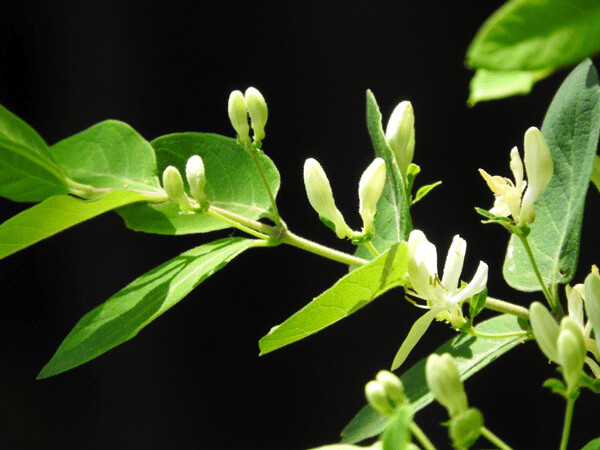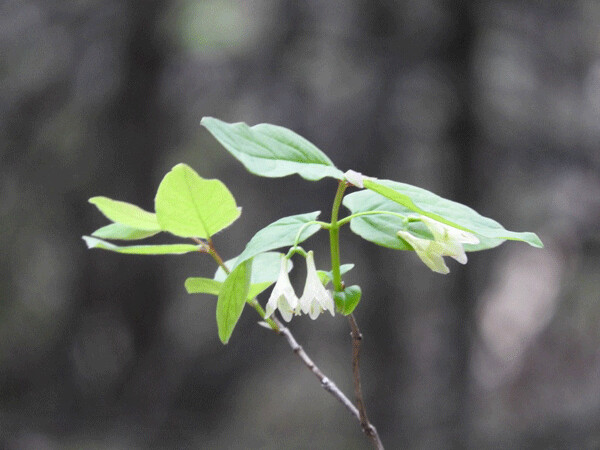News & Articles
Browse all content by date.

I love to meet old friends when I’m on a walk in the woods. Not human friends, mind you, but plant friends. During spring and early summer, when the undergrowth isn’t too thick, I often spot the distinctive shapes of honeysuckle bushes. Northern fly honeysuckle, (Lonicera canadensis), is an almost fragile looking native shrub with smooth oval leaves that line up in pairs along the twigs.

If you’re lucky, you might spot the honeysuckle’s pale yellow flowers dangling in their delicate pairs. Their fluted shape with a long nectar tube is a clue that hummingbirds love them. The flowers don’t last long, though, and are soon replaced by two green fruits, shaped a little bit like tiny footballs, and joined at their pointy ends. The berries ripen to a vibrant shade of red and really pop in the cool shade of the forest. Birds, especially robins and cardinals, love them. Sometimes (too often!) the old friend I meet in the woods is more of a “frenemy,” or a plant that I have a love-hate relationship with. I grew up with Tartarian honeysuckle (Lonicera tatarica) in my backyard, and spent many days gathering the round red and orange berries to use as pretend food in my playhouse. Now I know that this childhood friend can be quite invasive. A native of China, Manchuria, and Korea, it left behind its native predators when it came here, and tends to run rampant in our vacant lots and deciduous woods, creating impenetrable thickets in the worst cases. It’s joined by several other species of non-native invasive honeysuckles that all share the same invasive tendencies. While native and non-native honeysuckles share some characteristics, it’s not hard to tell them apart. All have pairs of white, pink or yellow flowers with a nectar tube and fluted petals. All have paired leaves (“opposite arrangement” to botanists,) and all have red or orange berries. The invasive honeysuckles get much bigger and bushier, though, and some species have pointed, serrated, or fuzzy leaves. Their abundant flowers are held upright. Plus, the berries on invasive honeysuckles are round instead of football-shaped.

The surest way to distinguish the honeysuckles in any season is to crack open a twig and look at the pith. The pith is the soft, spongy tissue in the center of the stem. In native honeysuckles the pith is pure and white. In non-native species the pith is either brown or hollow. Like many invasive species, the Eurasian species of honeysuckles tend to crowd out native plants and provide a lower quality food source to native animals. As birds and mammals eat the berries and disperse the seeds, non-native honeysuckles quickly invade open woodlands, old fields, and other disturbed sites, and form a dense thicket that prevents other native plants and trees from growing. The northern fly honeysuckle is one that gets pushed out by its cousin. With lower diversity, the wildlife cover is reduced, and cardinal nests in particular are less successful, despite the thicket. Fewer insects in the honeysuckle reduce food sources for many warblers and flycatchers. Although abundant, the berries actually contain less fat and energy than their native counterparts. When cedar waxwings eat too many red honeysuckle berries, the pigment tints their normally yellow tail tip and turns it orange. On the flip side, male cardinals who eat honeysuckle may be brighter red, even though they are less fit. Females have a harder time determining the healthiest mates. As you pass yard after yard surrounded by Eurasian honeysuckle hedges in full bloom, it’s easy to imagine how this invader got here. It was first introduced into North America as an ornamental in 1752! Many invasives got their start in the nursery trade, either as the main attraction or a hitchhiker. This June is Wisconsin’s 13th Annual Invasive Species Awareness Month, so it’s a good time to learn more about what you can do to help.
Prevention is worth an ounce of cure, so they say, and it is definitely easier to keep the weeds out than to get rid of them once they’re here. Do a little research before you buy new plants from a nursery, and try to choose to plant native species. Use those boot brushes at trailheads to make sure that you aren’t carrying seeds from trail to trail. Clean your equipment between locations, especially if you know that you’ve just been working in a place that has invasive species. Equipment includes boats! Aquatic invasive species are a big threat to Wisconsin lakes and streams, and making sure to clean, drain, and dry all of your equipment can help stop their spread. The Wisconsin DNR website has great information and Best Management Practices for a variety of situations to make sure that we aren’t accidentally spreading a new plague. If you discover an invasive species on your property or public land, contact Adam Haecker, Coordinator for the Northwoods Cooperative Weed Management Area (NCWMA) by calling 715-373-6167 or emailing ahaecker@bayfieldcounty.org. He, or a variety of the local land management agencies, can help you set up a management plant to control the offending invader. This June, be sure to enjoy all of the native flowers that brighten up our woods, and then protect their future by doing your part reduce the impact of invasive species.
Special Request: Special Note: Emily’s book, Natural Connections: Exploring Northwoods Nature through Science and Your Senses is here! Order your copy at http://cablemuseum.org/natural-connections-book/. Listen to the podcast at www.cablemusum.org!
For 50 years, the Cable Natural History Museum has served to connect you to the Northwoods. Come visit us in Cable, WI! Our new exhibit: "Better Together--Celebrating a Natural Community" is now open!
| Tweet |


